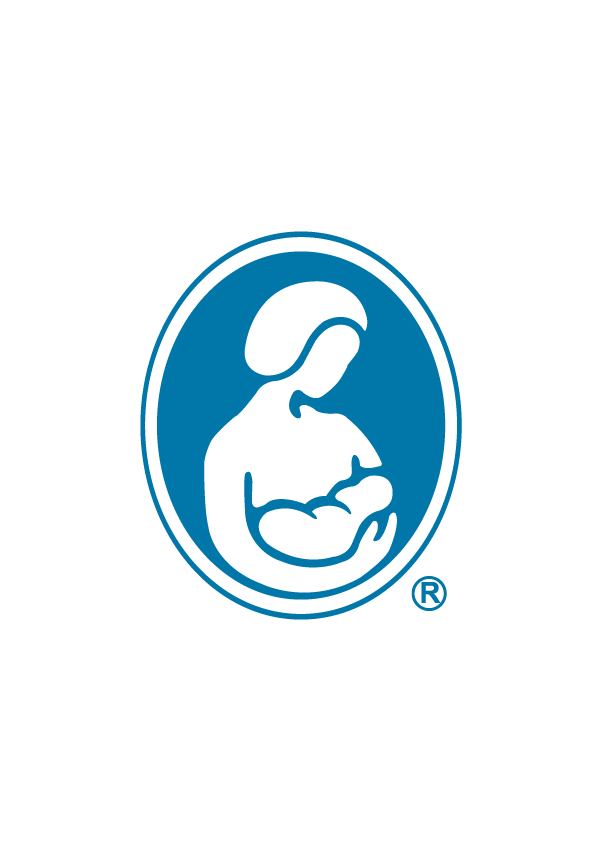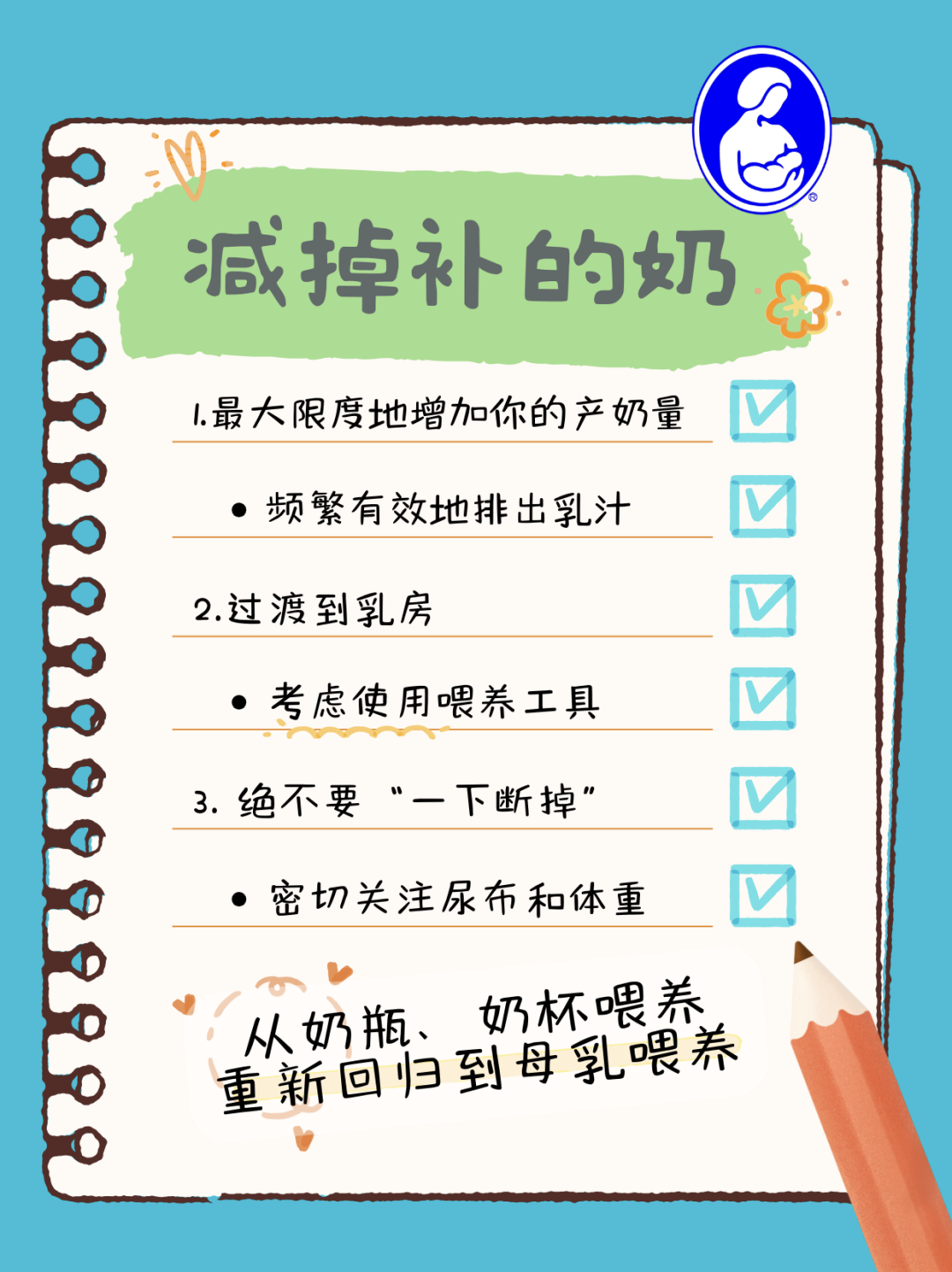

◆宝宝没有足够的能量来完成整个吃奶工作。
◆宝宝可能是早产、小于胎龄儿、身体不适、有黄疸(译者注:如“喂养不足型黄疸”),或者体重下降过多。
◆宝宝很渴望吃奶,也具备了很好的吃奶技能,但还没有吃到所需的奶量就睡着了。
◆宝宝需要时间、耐心和足够的奶量才能自行完成吃奶工作


宝宝需要足够的奶量来健康成长,并给予他足够的能量来吃奶。
一些宝宝需要额外的奶量——称为“补的奶”或“添加的奶”来补充或完全代替直接母乳喂养(亲喂)。


如果你想增加母乳量,这里有更多的信息。

建立奶量Establishing Your Milk Supply
奠定基础—帮助宝宝健康成长
在开始减少补的奶之前,宝宝要长势良好。已喂得很好的宝宝会喂得更好。宝宝长得越大个越壮实,就越能“长成”会吃母乳的宝宝。
可以与医护人员和母乳喂养支持者(例如国际母乳会哺乳辅导)密切合作,弄清楚宝宝需要补的奶量。
建议妈妈每次或每天给宝宝补一定量的奶,这个量可能要基于他的体重。如果不确定补多少,一个简单的方法就是让宝宝决定他所需的奶量。如果他看起来还想吃奶,就多给些。每次喂奶时他可能会吃不同的奶量。
使用喂养工具得小心,以免过度喂养。仅仅因为宝宝喝奶瓶里的奶,并不能说明他就需要它——宝宝会吮吸放进嘴里的任何东西。
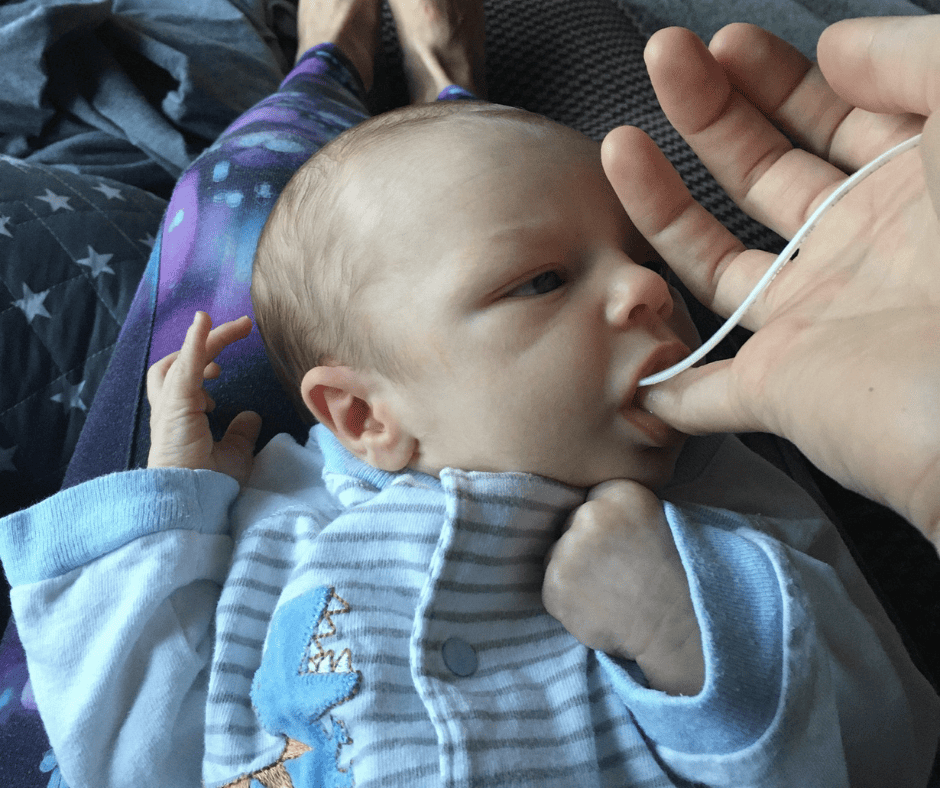
“间歇式喂奶”可以让宝宝喝奶的过程中休息一下,一旦饱了就停止不吃了。


给母乳喂养的宝宝引入奶瓶
如果宝宝很嗜睡,或是早产,他的食欲可能就不太好,需要积极鼓励他按需哺乳。判断宝宝是否吃到足够奶量的最可靠标准是他的生长发育。

如何知道婴儿是否吃到了足够的母乳 How to Know Your Baby is Getting Enough Milk
明确你的喂养目标
如果宝宝目前需要补奶,接下来要怎么做取决于妈妈的喂养目标是什么。
一些妈妈可能已经很满意目前的混合喂养方式了。挤出的母乳和/或配方奶可以单独喂来替代一顿直接哺乳。也可以直接哺乳时同时喂补奶,妈妈想喂多久都行。
一些妈妈选择挤出来母乳全部瓶喂给宝宝——这也是爱的巨大付出!
如果想多喂母乳、少补或不补奶,可以参考下面的内容:
-
需要母乳喂养协助者、助产士或医疗访视团队的支持。制定根据妈妈的个人情况量身定制一个对宝宝安全且适合妈妈的专属方案。
-
在努力减少补的奶的同时,密切关注宝宝的体重增长非常重要。隔一段时间就要例行给宝宝称体重:大约在5天龄、10天龄、6到8周龄时称,之后想的话可以每个月称一次。喂养顺利、宝宝也生长良好时,可以这样做。(注意:而当妈妈努力从补奶过渡到直接母乳喂养时,这往往就不够了。每周称一次体重更合适,如果情况顺利的话,逐渐改为每两周一次,再每月一次。)
逐渐减少是最安全的——无论是补的奶量还是称体重的频率!
以下的迹象说明宝宝准备好少补些奶了。但是判断是否继续减少补奶的最可靠指标是看宝宝的体重增长。
计划减少补的奶量
第一步:最大限度地增加妈妈的产奶量[如果宝宝已经只吃妈妈的奶了,就跳过这一步]。
如果宝宝目前还需要喝捐赠母乳或配方奶,而妈妈的目标是给他喂更多自己的母乳,那么最紧迫的任务就是努力提高妈妈的产奶量。这比宝宝学习母乳喂养或者改善母乳喂养更加时间紧迫。
宝宝天生就想母乳喂养,而且可以学习好几个星期(至少到足月2-3个月后,也许更长)。甚至有领养儿童年龄超过一岁了才开始母乳喂养的案例报告!
增加产奶量的窗口期较短。产奶量通常在产后一个月达到高峰,大部分的增长发生在产后前两周。1到6个月期间,奶量基本一样。过了第一个月,就不要期待妈妈的身体会增加产奶量了,所以增加奶量会越来越困难。尽管不试试我们永远不知道自己能做什么,但产后最初的几周过后,没人保证妈妈能产出更多母乳。
要想产更多的奶量,鸟儿就要早起才有虫吃。想要知道怎么做,请看如何提高母乳分泌量。频繁有效地排出乳汁是关键。如果想让乳房产更多奶量,就要不断提醒它们需要更多的乳汁(有点像唠叨!但是有效)。
“只要频繁母乳喂养就行了吗?”
很多妈妈可能会认为——或者有人甚至建议——要想产更多奶量,你只需要更多次地给宝宝哺乳。如果宝宝哺喂得很好,母乳喂养进展很顺利,可能这样做就是对的。但如果宝宝母乳喂养很困难,进展也不顺利,事实就并非如此了,可能很不安全。
这有点像让宝宝打两份工: 喂饱自己还要替妈妈增加奶量——即使他尚无能完成哪一项的成功史!而现在,妈妈需要替他做一部分(甚至是全部)工作。
急事先办!
先把精力集中在产奶量上是正解——再减少补的奶。面面俱到的做事会让人亚历山大——优先做最紧迫的。
-
宝宝就不用那么费力地从乳房吸奶了。 -
母乳喂养会让宝宝更满意——所以宝宝过渡到在乳房吃奶更多次会更容易。
-
如果在挤奶,每天挤出的奶量会增加。(能挤奶的次数有多有少,这很正常——关键是每天的总量)。 -
可能注意到,两次喂奶或挤奶之间,乳房很快就开始感觉涨奶了 (虽然并不总是如此)。 -
如果宝宝每天母乳喂养几次的话,他可能会吞咽地更频繁、哺乳时间更长、吃完后看起来更满足。 -
如果宝宝母乳喂养得越多,他就会长得越快。
-
奶量要足以满足宝宝所需 -
奶量要足以满足宝宝健康生长
第一步是用妈妈的母乳来替代一部分或全部捐赠母乳或配方奶。
如果宝宝早产或身体不适,他目前可能只吃少量的奶。假如妈妈的目标是他生长时只吃你的母乳,就要把目标定为他以后需要的奶量上,而不仅仅是现在需要的量。那么上面的数字可以作为参考。
妈妈越早开始挤奶、挤得越频繁、产的奶量就可能越多。如果最终产出的奶量超过了宝宝的当下所需,可以冷冻起来以后备用,或者捐给母乳库,让其他的早产儿也受益。
如果妈妈无法产出宝宝所需的全部奶量,当意识到他将一直需要补充捐赠母乳或配方奶时妈妈可能会特别沮丧。尽管竭尽所能,如果产奶量不再增长了,或者根本就没有增加,可以寻求母乳喂养支持者的帮助,来识别出是否已达到这个峰值。
有些妈妈想知道,如果不能产出宝宝所需要的全部奶量,那坚持下去是否还有意义。虽然只有妈妈自己才能衡量出所做的努力是否值得,但人类乳汁无论多少都会以其它乳汁无法企及的方式去保护宝宝。
如果妈妈现在正处于一个新阶段: 维持住已有的产奶量。可以试着看看需要哺乳或挤奶多少次才能维持住这个奶量。因为只要一直排出这个奶量,就会一直产出这个量。
母乳喂养是个长期过程,要为未来的目标而思考计划。等宝宝六个月左右开始吃辅食后,他对奶量的需求就会逐渐下降。这时往往有可能减少或不再需要补充捐赠母乳或配方奶,可以继续母乳喂养或挤奶到多久都行。很多曾经在产后前几个月努力奋战的奶量低的妈妈们发现这时才真正地放松并享受母乳喂养了。

当妈妈们需要支持的时候可以把这篇文章分享给自己的主管医护人员,从而得到更多的支持。
第二步 :过渡到乳房
当妈妈已经有或能产出宝宝所需要的奶量时,就准备考虑减少补的奶吧。与母乳喂养帮助者合作,为妈妈和宝宝量身定制一个计划。当地的国际母乳会哺乳辅导(哺乳顾问)能提供支持或帮助妈妈找到其他能支持的人。
许多地区都有国家医疗服务体系的婴儿喂养团队来帮助有复杂喂养问题的家庭——可以向助产士或家访护士询问从哪儿得到专家的帮助。
如果宝宝还没有母乳喂养,请参考如何帮助宝宝与乳房建立良好关系的小贴士。
庆祝一点一滴的进步和成长:做肌肤接触时用杯子或奶瓶喂奶;宝宝吃完奶之后脸枕在妈妈乳房上睡着;补一些奶后在乳房上短暂尝试吸吮几下。即使宝宝只能在乳房上吃一小会儿,都是难能可贵的。
学习母乳喂养遇到困难时,就像锻炼一样:没有进行大量短距离训练的情况下我们是不会去跑马拉松的。宝宝从母乳喂养中得到的远超乎乳汁本身——别忘了享受剩下的好处!
确保正确使用喂养工具。它们是用来支持母乳喂养的,而不是与之竞争的。宝宝很精明——如果母乳喂养对他很难,而另一种方式更容易,那他就会执着用另一个。
考虑一些其它的(或不同的)喂养工具。
用杯子或哺乳辅助器(如下图)来替代部分或全部奶瓶喂养。不用或少用人工奶头(包括安抚奶嘴)可以鼓励不情愿的宝宝在乳房上待更长时间。
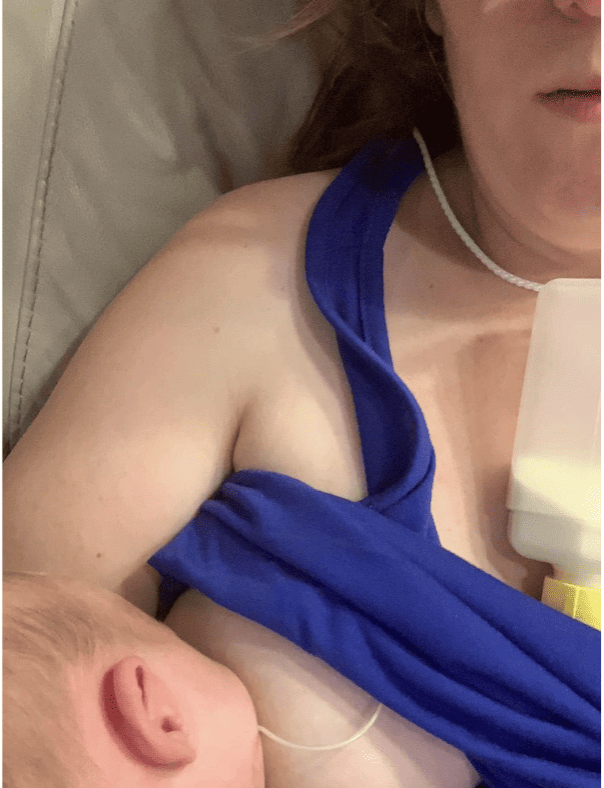
“哺乳辅助器”(有时也叫泌乳辅助器、乳旁加奶器)可以让妈妈在宝宝哺乳时,通过放在乳头上的一根细管,在乳房上喂给他挤出的母乳或配方奶。这是个很棒的工具,可以帮助不情愿的宝宝回归乳房,或产奶量低的话也可以长期使用。
另一个工具是乳盾——由一层薄薄的硅胶制成,放在你的乳头上。大小合适并能与乳房皮肤贴合的话,乳盾能帮助奶瓶喂养的宝宝过渡到乳房上,或帮助吮吸力弱的宝宝 (例如早产儿)吃到更多的母乳。
如果妈妈有兴趣想要尝试这些工具,那最好是向知道怎么使用它们的母乳喂养支持者学习用法,这样会很有帮助。
【以上追奶建议只供参考,每个哺乳妈妈经历是独一无二的。可以寻求国际母乳会哺乳辅导的帮助,来量身定制适合的追奶方案】

当你把一切都安排妥当……
-
你的产奶量已是所需的奶量,或已到峰值
-
宝宝长得很好
-
你认真选了喂养工具,并且用得很好
-
宝宝愿意在乳房上吃奶,至少有时愿意
…接下来呢?虽然这个过程每个宝宝都不一样,但是下面这些原则能一直帮助你和你的母乳喂养支持者。
绝对不要“一下断掉”!有时父母被建议一下停掉补奶,来“强迫”宝宝母乳喂养。除非宝宝已经差不多要纯母乳喂养了,长得也很好,否则非常不安全。宝宝从来不会故意不好好地吃母乳——如果他吃得不好,那是因为他无法吃好,而不是因为他不愿吃好!宝宝需要从这个过程吃到他需要的正常奶量。
观察宝宝是否有准备就绪的迹象。曾经缺少能量吃奶的宝宝早晚会表现出他准备好吃更多的奶了。例如,如果宝宝早产并嗜睡,或者舌系带过紧,总有一天妈妈会注意到他的喂奶情况在变化。感觉就像他吸吮得更强有力了,也许还能吃得更久一些。他可能开始想少吃些补的奶。这时他就准备好开始更努力地吃奶了。
稳扎稳打,谨慎地过渡是值得的。宝宝还没有母乳喂养的成功记录,他可能还需要一段时间才能熟练地吃母乳。如果他比较小、精力不足或身体不适——几乎吃不了奶——别指望他一下子就可以自行吃好母乳。
如果宝宝早产,至少要等到他原本的预产期,或者再久一点,他才能自己吃母乳。他在这个世界上远比足月儿要处理更多的事情。他的并发症越多,学会自己吃奶所需的时间可能就越长。我们知道,不清楚究竟要花多长时间真的很令人沮丧。和其他已经转变成功的家庭沟通将是妈妈这时能做的最有用的事情,并且当地的国际母乳会小组很愿意给妈妈们提供支持。
小试一把,密切关注宝宝的尿布和体重。如果妈妈觉得宝宝可能准备好了向前迈进一步——那就试试吧!多喂几次母乳,少补一点奶。例如每天如果补300毫升的奶,那就减到270毫升看看会怎么样。还可以把减少的这个量分配到几次喂奶当中。如果宝宝能从乳房吃到更多母乳,他的大小便尿布就还会是正常量,并且长得也很好。如果他的尿布量少了,或者体重增长变慢了,这时候就需要后退一步,以后再试。
在这个阶段定期给宝宝称体重非常重要。如果进展不顺利的话,两周或者一个月称一次对宝宝和妈妈的奶量来说都太长时间了。
两次称体重之间,要关注宝宝对减少补的奶量反应如何。如果减少了补的奶量后宝宝看起来不满意,这可能就表明奶量减得太多、太快了。可以试着补完奶后再喂乳房,看看孩子有什么反应。他可能会满足于待在乳房上的舒适感,而不是吃更多乳汁——否则他可能还需要再补些奶。
妈妈如果还在挤奶,要逐渐减少挤的奶量。如果是已经通过挤奶辛苦建立起了奶量,妈妈就会知道这是多么珍贵了!每次只减一次挤奶的次数。只有宝宝一直长得很好,才能采取下一步行动。例如:如果原来是每24小时挤奶6次,就从减少到5次开始,同时花更多时间母乳喂养。
过几天(理想情况下不超过一周)再称一次宝宝的体重。如果宝宝这一周长得很好,就把吸奶次数减少到四次,然后以此类推。这样做妈妈可能会觉得慢得很让人郁闷,同时我们也不想冒险毁掉自己努力增长起来的奶量,所以,如果妈妈发现乳房变得充盈很不舒服,这可能表明宝宝还没达到希望地那样高效吃奶。过度涨满的乳房会减少产奶量。少挤出一些乳汁来让乳房舒服一些,直到准备好试着再减少一次挤奶为止。
预计会进两步,退一步。要是宝宝处于最好的状态时(即健康、休息好了和情绪稳定时),他们会竭尽所能去吃奶。通常宝宝会在每天上午吃得更好,而当他疲惫、沮丧或者心情不好时,就容易崩溃。谁都会有糟糕的一天,宝宝也一样!
如果某次母乳喂得不太顺利,妈妈可以随时按下“暂停键”,补一次奶来替代。因为如果妈妈和孩子都不开心了,强迫也没用。下一次或者第二天哺乳时,情况可能会好转。如果没变好,那就暂停一下,还可以和自己的母乳喂养支持者谈谈接下来该怎么办。
记录变化。一直做下去,收集一些“数据”就会很有用。这有助于妈妈和自己的母乳喂养支持者看到事情是如何随着时间的推移改变的。不需要记太细——记每天的总数就好。可以用应用程序、电子表格或一张纸来记录:每天喂了多少挤出的母乳、捐赠母乳或配方奶;宝宝母乳喂养了多少次;宝宝大小便的尿布数量。诸如此类的数据,这些数据连同宝宝的体重都记录会给到足够的信息来说明计划执行的情况。

减少补的奶就像过一座看起来有点摇摇欲坠的桥一样。一开始我们不太确定这座桥是否能承受住自己,所以我们也不会一下跳到桥中央,而是一步一个脚印地走,先检查桥是否能承受住自己的体重,然后再走下一步。而如果它一开始就垮塌,我们就会跳回去!
就像母乳喂养一样,减少补的奶也是一门艺术。需要妈妈有足够的耐心和良好的支持。国际母乳会小组中的很多妈妈都经历过这个过程,她们非常愿意鼓励每一位妈妈。
妈妈们也许会竭尽所能去实现目标——比如纯母乳喂养宝宝,或者只(瓶)喂母乳给宝宝。不管结果如何,妈妈都能找到一种适合自己和宝宝的喂养方式,而且两人都能享受它。不管妈妈怎么喂养,我们都在此给你们提供帮助。
作者:杰妮· 乔伊斯,写于2023年3月,将于2026年3月再次审核。
WEANING FROM SUPPLEMENTS
Making the transition from using bottles, cups etc., to feeding at the breast
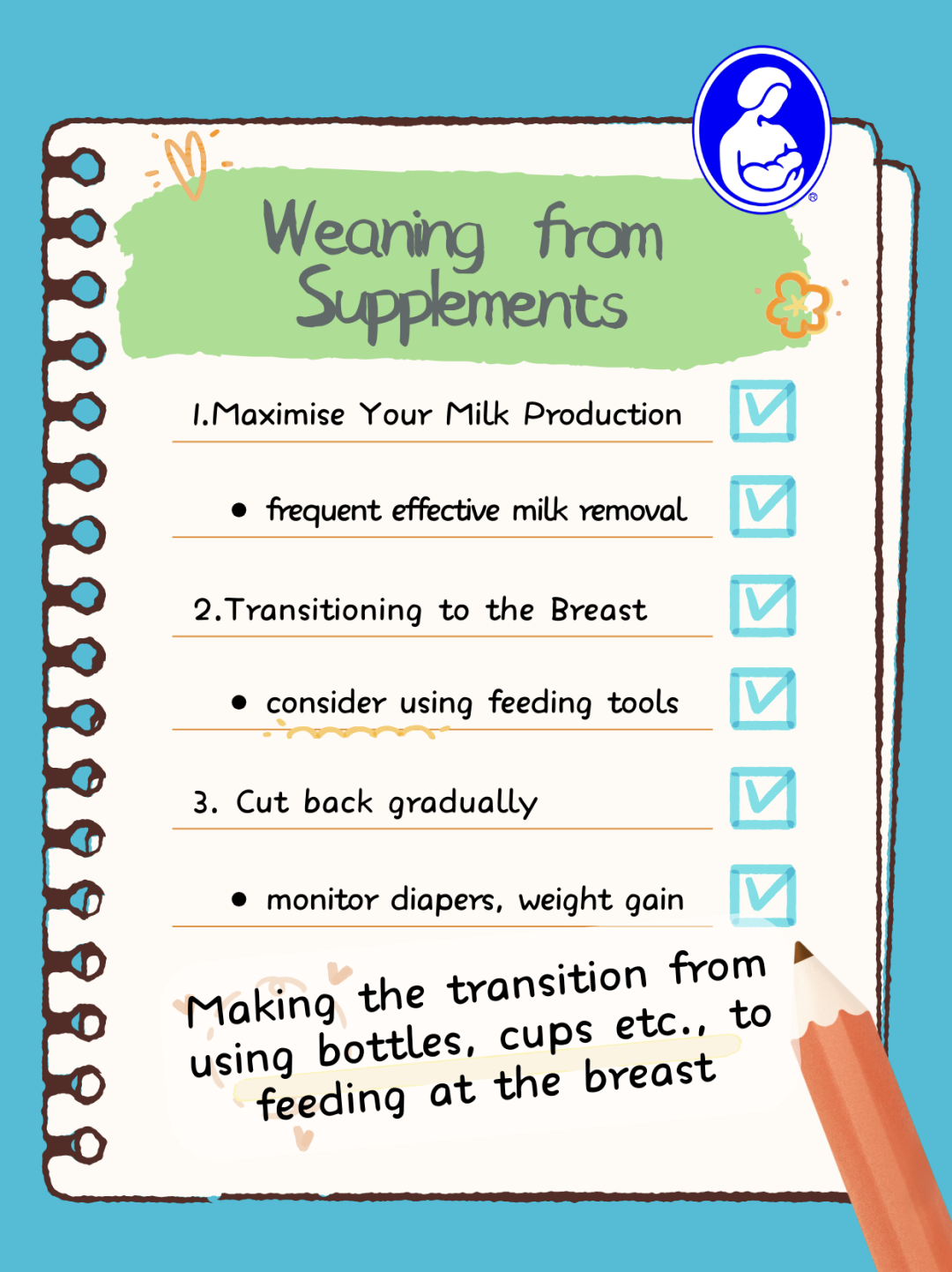
There are lots of reasons babies might need more milk than they can get directly at the breast:
-
They don’t have enough energy to do all the work of feeding. They may have been born early or small-for-dates, or are unwell, or jaundiced, or have lost a lot of weight. They may be keen to feed, and have good feeding skills, but they fall asleep before they’ve taken as much milk as they need. They need time, patience, and plenty of milk, before they can do all the work of feeding for themselves.
and/or
-
There isn’t enough milk available at the breast to meet all their needs. This might happen if:
°Milk is slow to increase in the early days after birth, for example because the birth was very difficult, or if you have diabetes.
°Not enough milk is removed from the breasts in the early days after birth. This can happen because the baby wasn’t breastfeeding often enough (perhaps because they were very sleepy, or formula was being given instead of breastfeeding), or feeding was inefficient (perhaps they weren’t deeply attached at the breast, or had a tongue tie. Most of us need to remove milk from our breasts at least 8 – 12 times in 24 hours, in the early weeks, to bring in a full milk supply.
°You have a limitation on how much milk you can make. This could be because of previous breast surgery, hormonal issues, or other factors related to your breasts or your health.
Here is more information on how milk production works.
Babies need enough milk to grow well, and to give them enough energy to feed. Some babies need extra milk – known as “supplements” or “top ups”, as well as, or instead of, direct breastfeeding. Here is more information about increasing your milk production
Many babies who have needed supplements can go on to breastfeed exclusively (get all the milk they need, directly at the breast).But not all can. For many reasons, we are seeing more families with complications that make exclusive breastfeeding out of reach. No one can guarantee, right now, how this is going to turn out for you. But whether or not you need to keep using supplements, we can help you find a way of feeding that works for you and your baby.

Laying the foundations – Helping your baby to grow well
Your baby needs to be growing well, before you start reducing supplements. Babies who are well fed, feed better. The bigger and stronger they get, the more they can “grow into” breastfeeding. Work closely with your healthcare providers and a breastfeeding supporter (for example LLL Leader), to figure out the amount of supplement your baby needs.
It might be suggested that you feed your baby a certain volume of supplement each feed or each day, perhaps based on their weight. A simpler approach, if you’re not sure what to do, is to let your baby show you the amount they need. Offer more, if they seem to want it. They might take very different amounts at different feeds.
It’s important to use feeding tools carefully, to avoid over-feeding. Just because a baby drinks milk from a bottle doesn’t necessarily mean they needed it – babies will suck on anything you put in their mouth.“Paced feeding” enables your baby to take breaks, and stop when they’ve had enough. Here is more information on how to use bottles.
If your baby is very sleepy, or premature, their appetite might not be working well yet, and they may need active encouragement to take as much as they need. Your baby’s growth is the most reliable guide to whether they’re getting enough milk. This article has information on how to work out if your baby is getting enough milk.
Define your feeding goal
If your baby needs supplements at the moment, what you do next depends on what your feeding goal is.
-
You might already be happy with the mix of feeding you’ve got. Expressed milk and/or formula can be used alongside, or instead, of direct breastfeeding, for as long as you want.
-
Some parents feed their babies entirely on expressed milk – a huge labour of love.
If you would prefer to be doing more breastfeeding, and less (or no) supplementing, read on…
You also need support from a breastfeeding helper, and your midwifery or health visiting team. You need a plan that is safe for your baby, and tailored to your individual situation.
It is really important to keep a close eye on your baby’s growth while you are working on reducing supplements. Babies are routinely weighed at certain times: around five days, ten days, six to eight weeks, and then once a month, if you want to. This is fine when feeding is going smoothly, and babies are thriving. This is not often enough while you’re working on transitioning from supplements to direct breastfeeding. Weekly weighing is more appropriate, gradually moving to fortnightly and then monthly, when it’s going well.
Gradual weaning is safest – both from the supplements and the scales!
You can find more information below on signs that your baby is ready to manage with less supplement. But your baby’s growth is the most reliable indicator of how things are going. You might find it useful to share this article with your healthcare team.
Plan to reduce supplements
Step One: Maximise Your Milk Production
[If your baby is already fed only on your milk, you can skip this step].
If your baby needs donor milk or formula at the moment, and your goal is to feed them more of your own milk, then the most urgent task is to work on your milk production. This is much more time-critical than your baby learning to breastfeed, or to breastfeed better.
Babies come hardwired to breastfeed, and can learn for many weeks (at least 2-3 months, maybe longer) after term birth. There are even case reports of adopted children aged over a year starting to breastfeed!3
The time-window for increasing milk production is shorter. Milk production normally reaches its peak by a month after birth, with most of the increase happening in the first two weeks. From 1-6 months, it stays about the same.4 After the first month, your body is not expecting to increase the amount of milk you’re making, so it tends to get harder to increase it. Though you never know what you can do until you try, after the early weeks there are no guarantees of being able to get a lot more milk.
If you want to make more milk, the earlier you act, the better your chances. To find out how, see How to Increase Your Milk Supply. Frequent, effective milk removal is key. If you want your breasts to make more milk, you need to keep reminding them that you need more (it’s a bit like nagging!).
“Just breastfeed more often”?
You might assume – or even be advised – that all you need to do to make more milk is to breastfeed your baby more often. This may be true, when a baby is good at breastfeeding, and breastfeeding is going smoothly. But it’s not true, and might be really unsafe, if breastfeeding is difficult for your baby, and it’s not yet going well.
It’s a bit like asking your baby to do two jobs: feed themself and do the work of increasing your milk production – even though they don’t yet have a track record of doing even one of these jobs successfully! For now, you will need to do some (or even all) of the work for them.
First Things FirstIt makes sense to concentrate on your milk production first – before reducing supplements. It can feel overwhelming to try and do everything at once – prioritise what is most urgent. When you have more milk:
-
Your baby won’t have to work so hard to remove milk from the breast.
-
Breastfeeding will be more rewarding – so it will be easier to transition your baby to doing more breastfeeding.
-
Signs that your milk production is increasing
-
If you’re expressing your milk, the amount you’re able to express each day will have increased. (It’s normal to have times when you can express more, or less – the daily total is what counts).
-
You might notice that your breasts start to feel fuller more quickly between feeds or expressing sessions (although this is not always the case).
-
If your baby is doing some direct breastfeeding, they might swallow more often, feed for longer and seem more satisfied after feeds.
-
If your baby is doing quite a bit of breastfeeding, they might grow faster.
How much milk do you need?It might be useful to know that between about one and six months, an average baby takes about 800ml in 24 hours. But some babies thrive on as little as 600ml, while some take as much as 1300ml.5 The practical answer is:
-
Enough to satisfy your baby and
-
Enough for your baby to grow well.
The first step is to replace some or all of the donor milk or formula supplements with supplements of your own milk.
If your baby is premature or unwell, they might only be taking small amounts of milk at the moment. If your goal is to feed them only on your milk as they grow, you will need to aim to get the kind of amounts they’ll need later, not just the amounts they need now. The figures above can be a guide.
The earlier you start expressing, and the more often you express, the more milk you’re likely to make. If you end up making more than your baby needs at the moment, you could freeze it for later use, or donate it to a Milk Bank, to benefit other premature babies.
When you’re not able to produce all the milk your baby needs, it can feel really disappointing to realise that they will keep needing donor milk or formula as well. If, despite your best efforts, the amount of milk you’re making has stopped increasing, or hasn’t increased at all, you have probably reached the limit of the amount you can make. A breastfeeding supporter can help you work out if you’ve reached this point.
Some of us wonder whether, if we can’t make all the milk our baby needs, there is any point in carrying on at all. While only you can make the calculation about whether the effort you’re putting in is worth it, any amount of human milk protects babies in ways no other milk can.6,7
Now you are in a new phase: maintaining the amount of milk you’ve got. You can experiment to see how many times you still need to feed or express, to keep up this amount. As long as you keep removing this amount, you will keep making this amount.
It’s a long game. After babies start eating family foods, around six months, their need for milk gradually reduces. It’s often possible to reduce, and maybe stop using, supplements of donor or formula milk, while keeping on breastfeeding or expressing for as long as you want. Many of us who’ve had to deal with low milk production in the early months find that we can really relax and enjoy breastfeeding at this stage.

Step Two – Transitioning to the Breast
When you’ve got as much milk as you need, or can get, you’re ready to think about reducing supplements. Work with a breastfeeding helper to make a tailored plan for you and your baby. Your local La Leche League Leaders (breastfeeding counselors) may be able to support you themselves, or help you find someone else who can. Many areas have an NHS Infant Feeding Team to help families with complex feeding issues – ask your midwife or health visitor where you can get specialist help.
-
If your baby isn’t breastfeeding yet, see tips on how to help your baby make a positive relationship with the breast.
-
Celebrate the baby steps: drinking from a cup or bottle while in skin-to-skin contact; falling asleep afterwards with cheek pillowed on breast; having a short try at the breast after taking some supplement. If your baby is able to stay at the breast for even a short time, it’s valuable practice. Learning to breastfeed, when something is making it difficult, is like exercising: you wouldn’t expect to run a marathon without doing lots of much shorter training runs first. Your baby gets much more from breastfeeding than just milk – don’t forget to savour the other stuff!
-
Make sure you’re using your feeding tools well. They’re there to support breastfeeding, not compete with it. Babies are very smart – if breastfeeding is difficult for them, and another method is much easier, they might prefer to stick with the other method.
-
Consider some extra (or different) feeding tools.
If you’re interested in trying these tools, it’s helpful to work with a breastfeeding supporter who knows how to use them.

When you’ve got all the pieces in place…
-
Your milk supply is as high as you need, or can get
-
Your baby is growing well
-
You’ve chosen feeding tools carefully, and are using them well
-
Your baby is willing to feed at the breast, at least sometimes
…What next? While the process will look different for every baby, these principles can help you and your breastfeeding supporters along the way.
-
Never go “cold turkey”! Sometimes, parents are advised to stop using supplements suddenly, to “force” their baby to breastfeed. Unless your baby is almost exclusively breastfeeding already, and growing well, this is extremely unsafe. Babies never choose not to breastfeed well – if they don’t, it’s because they can’t, not because they won’t! Your baby needs their usual amount of milk throughout this process.
-
Watch your baby for signs of readiness. Babies who lacked energy to feed show us when they are ready to take on more work. If your baby was premature and sleepy, or has had a tongue tie division, for example, there will come a time when you start to notice that their feeding is changing. It feels like they’re sucking more strongly, and maybe keeping it up for a bit longer. They might start wanting less supplement. Now they’re ready to begin doing more of the work of feeding.
-
Take it steady. We know it’s really tempting to rush this – you want to breastfeed! – but it pays to make the transition carefully. Your baby doesn’t have a track record of breastfeeding yet, and it might take a while before they’re good at it. If they’re small, low in energy or unwell, they’re unlikely to be able to do all the work of feeding today, when yesterday they were doing little or none.
If your baby was born prematurely, expect it to take at least until their original due date, plus a bit longer, before they’re able to do all the work. They’ve had more to cope with out here in the world, than if they’d been born later. The more health complications they’ve had, the more time they’re likely to need. We know it’s really frustrating not to know exactly how long this will take. Connecting with other families who have already made this transition may be the most helpful thing you can do at this stage. Your local LLL group would love to support you.
-
Do a small trial, keeping a close eye on your baby’s nappies, and weight. If you feel your baby might be ready for a step forward – try it! Breastfeed a bit more, and offer a little less supplement. If you’ve been giving, say, 300ml per day, see what happens if you reduce it to 270ml. You could spread this reduction out over more than one feed. If your baby is able to take more milk from the breast, they’ll continue to produce wet and dirty nappies as normal, and to grow well. If their nappy output reduces, or their weight gain slows, you will need to go back a step, and try again later.
It’s really important to weigh your baby regularly during this stage. Two weeks, or a month, is a really long time for a baby – and for your milk supply – if things turn out not to be going well.
-
In between weight checks, notice how your baby is responding to any reduction in supplement. If your baby seems unsatisfied after the reduced supplement, this may be a sign that it’s been reduced by too much, too fast. You could try offering the breast after a supplement, and see how they respond. They might be satisfied with the comfort that being at the breast provides, rather than more milk – or they might need more supplement.
-
If you’re expressing, cut back gradually. If you’ve already been working hard to build your milk supply by expressing, you know exactly how precious it is! Reduce the number of times you express one at a time. Only take the next step if your baby continues to grow well. For example: if you’ve been expressing six times in 24 hours, start by reducing to five, spending more time breastfeeding.
After a few days (ideally no more than a week), weigh your baby again. If your baby has grown well that week, reduce your pumping sessions to four, and repeat. It might feel frustratingly slow, but you don’t want to risk damaging the milk supply you’ve worked so hard for. If you notice your breasts becoming uncomfortably full, it may be a sign that your baby is not yet as efficient at the breast as you hoped. Over-full breasts reduce milk production. Keep your breasts comfortable by expressing a little more, until you’re ready to experiment with reducing expressing again.
-
Expect some steps backwards, as well as forward. Babies who are finding breastfeeding hard work will do their best job when they’re in their best state: healthy, well-rested and calm. Expect better feeding early in the day, and for things to feel like they’re falling apart when they’re tired, frustrated, or in a bad mood. Anyone can have a bad day, including babies!
If a breastfeeding session isn’t going well, you can always hit “pause”, and offer a supplement instead. There’s no point forcing it, if both of you are upset. The next feed, or the next day, might go better. If it doesn’t, take a break, and talk to your breastfeeding helper about what to do next.
-
Track changes. It’s helpful to collect some ‘data’ as you go along. This helps you, and your breastfeeding supporter, see how things are changing over time. You don’t need to go into huge detail – daily totals are fine. You could use an app, a spreadsheet or just a piece of paper, to record:
This, along with your baby’s weights recorded in their red book, will give you enough information to tell how your plan is working.
Reducing supplements is like crossing over a bridge which looks a bit rickety. You’re not quite sure if it will hold you up. You don’t jump straight into the middle – you take one step at a time, checking it’s holding your weight, before you take the next one. If it starts to give way – you jump backwards!
Just like breastfeeding, reducing supplements is an art. You need plenty of patience, and good support. Many mothers in our groups have been through this process, and would love to encourage you. Maybe you will get all the way to your goal – such as exclusively breastfeeding your baby, or feeding them only on your milk – or maybe you won’t. However it turns out, you can find a way of feeding that works for you and your baby, and which you can both enjoy. Whatever feeding looks like for you, we’re here to help.
Written by Jayne Joyce, March 2023. Review due March 2026.

资料来源:https://www.laleche.org.uk/weaning-from-supplements/
参考文献 References:
-
Azad MB, Vehling L, Chan D, et al. Infant Feeding and Weight Gain: Separating Breast Milk From Breastfeeding and Formula From Food. Pediatrics. 2018;142(4):e20181092. doi:10.1542/peds.2018-1092
-
Mildon, A., Francis, J., Stewart, S., Underhill, B., Ng, Y. M., Rousseau, C., Di Ruggiero, E., Dennis, C. L., O’Connor, D. L., & Sellen, D. W. (2022). High levels of breastmilk feeding despite a low rate of exclusive breastfeeding for 6 months in a cohort of vulnerable women in Toronto, Canada. Maternal & child nutrition, 18(1), e13260. https://doi.org/10.1111/mcn.13260
-
Post-Institutionalized Adopted Children Who Seek Breastfeeding from their New Mothers. Karleen D Gribble. Journal of Prenatal & Perinatal Psychology & Health; Spring 2005; 19, 3.
-
Kent, Jacqueline C et al. “Principles for maintaining or increasing breast milk production.” Journal of obstetric, gynecologic, and neonatal nursing : JOGNN vol. 41,1 (2012): 114-121. doi:10.1111/j.1552-6909.2011.01313.x
-
Kent, Jacqueline C et al. “Volume and frequency of breastfeedings and fat content of breast milk throughout the day.” Pediatrics vol. 117,3 (2006): e387-95. doi:10.1542/peds.2005-1417
-
Thompson JMD, Tanabe K, Moon RY, et al. Duration of Breastfeeding and Risk of SIDS: An Individual Participant Data Meta-analysis. Pediatrics. 2017;140(5):e20171324. doi:10.1542/peds.2017-1324
-
Chiu, C. Y., Liao, S. L., Su, K. W., Tsai, M. H., Hua, M. C., Lai, S. H., Chen, L. C., Yao, T. C., Yeh, K. W., & Huang, J. L. (2016). Exclusive or Partial Breastfeeding for 6 Months Is Associated With Reduced Milk Sensitization and Risk of Eczema in Early Childhood: The PATCH Birth Cohort Study. Medicine, 95(15), e3391. https://doi.org/10.1097/MD.0000000000003391
-
Meier PP, Brown LP, Hurst NM, et al. Nipple shields for preterm infants: effect on milk transfer and duration of breastfeeding. J Hum Lact. 2000;16(2):106-131. doi:10.1177/089033440001600205

END
翻译:传艳
审核:Lynn、Marien、曾笑仪
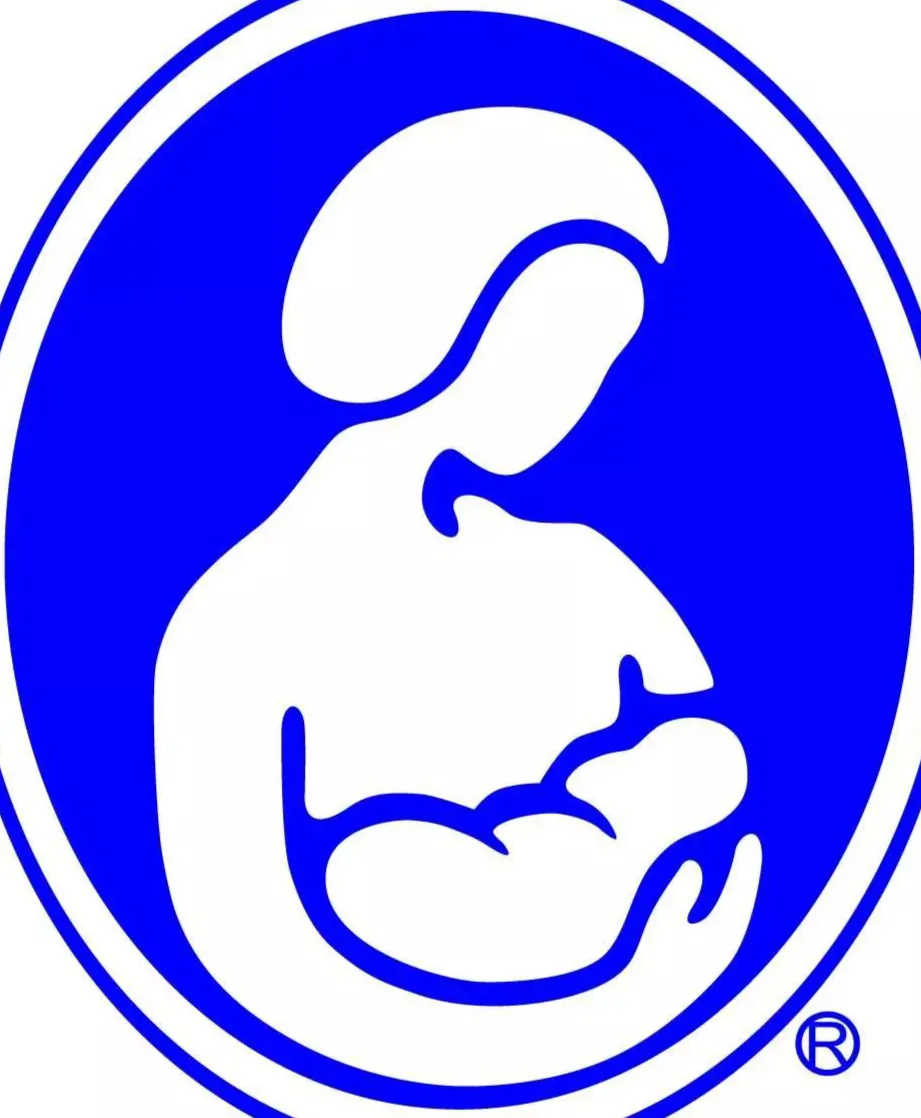
找到我们
微信公众号|视频号|小红书|抖音|新浪微博|今日头条|哔哩哔哩|优酷
搜索关键字“国际母乳会LLL”


更多阅读资料,
欢迎大家访问“国际母乳会LLL”官网:
https://www.muruhui.org/
分享
收藏
点赞
在看

做公益也有运营成本!
你的支持和赞赏可以让更多的妈妈获益!
本篇文章来源于微信公众号: 国际母乳会LLL
